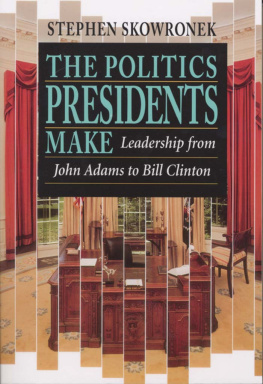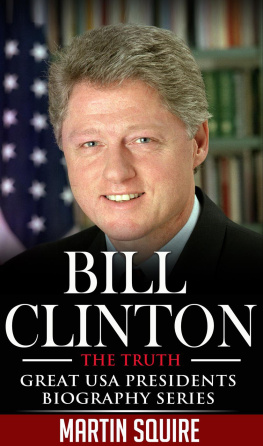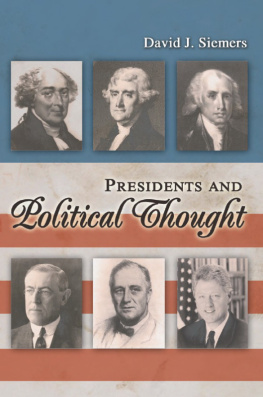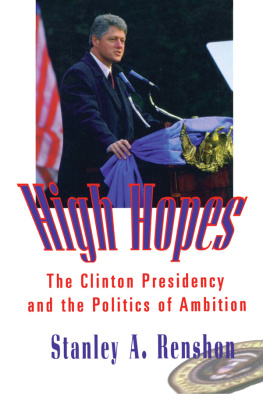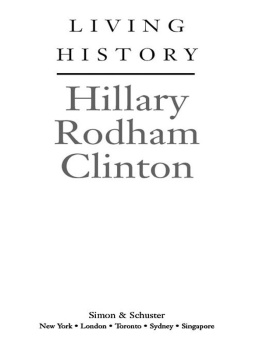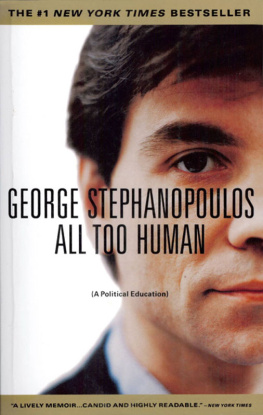Copyright 1993, 1997 by the President and Fellows of Harvard College
All rights reserved
Printed in the United States of America
Library of Congress Cataloging-in-Publication Data
Skowronek, Stephen.
The politics presidents make : leadership from John Adams to Bill Clinton / Stephen Skowronek.
p. cm.
Originally published : Cambridge, Mass. : Belknap Press, 1993. Includes bibliographical references and index.
ISBN 0-674-68937-2
1. PresidentsUnited StatesHistory. 2. Political leadershipUnited StatesHistory.
I. Title.
JK511.S55 1997
352.2360973dc21 97-7818
Acknowledgments
A BOUT a decade ago, when the Reagan Revolution was afoot, I decided to undertake a general study of presidents as agents of political change. Faith in the transformative capacities of the presidency seemed to be giving rise to ever greater expectations and ever more profound frustrations, but so far as I could tell no one had attempted to analyze those capacities in a systematic way. Such an assessment must deal with a vast and varied record, and that, no doubt, is one reason why thoughts about this matter have tended to remain impressionistic. Yet, anyone inclined to look back through presidential history will discover that a substantial amount of guidance and insight is readily accessible. Each piece of the puzzle is illuminated by many fine biographies, period studies, and administration chronicles. I have made extensive use of these works, and while I have entered the debates that surround individual incumbents with my own more general purposes in view, the story that I tell is in large part a reflection on the great themes that I found running through this literature.
I set to work in earnest on this project as a fellow at the Woodrow Wilson International Center for Scholars, and I benefited enormously from the lively forum for interdisciplinary exchange created there by Michael Lacey, the Director of the Division of United States Studies. My opportunity for research in Washington was extended through the courtesy of Paul Peterson and the Brookings Institution.
Whatever merit there is to this book is a credit widely shared. Karen Orren and I began a discussion about American political development when we were colleagues together at UCLA, and the history of the presidents has figured prominently in our conversations ever since. From my first thoughts about this project through the final revision of the manuscript, Karen has sharpened my thinking with keen insights of her own and responded to my efforts with the disarming candor of a stalwart friend.
I was fortunate to join the Yale Political Science Department at a moment when its interest in historical work was blossoming. My colleagues have read and reread these chapters, offering patient support as well as careful criticism. Bruce Ackerman, David Cameron, Robert Dahl, James Fesler, Victoria Hattam, David Mayhew, David Plotke, Susan Rose-Ackerman, George Shulman, Ian Shapiro, Rogers Smith, Steven Smith, and Alex Wendt all offered valuable counsel.
Several leading scholars in presidential studies took the time to look at this manuscript in whole or in part and to give me the benefit of their seasoned perspectives and intimate knowledge of the field. Michael Nelson was an early promoter of the project and an astute critic of the results. I also received careful readings from George C. Edwards III, Sidney Milkis, Bruce Miroff, Richard Pious, Jeffrey Tulis, Aaron Wildavsky, and the late J. David Greenstone. Comments from two scholars outside the sphere of presidential studiesIra Katznelson and Brian Baloghwere especially helpful in probing the broader issues raised by the concept and design of the study.
Aida Donald and Susan Wallace managed the publication of the book with alacrity and consummate professionalism. Mary Whitney provided able office support at Yale. I have had excellent research assistance all along; Mark Harmon, Corey Robin, Adam Sheingate, and Keith Whittington were especially helpful in the final phases. My wife, Susan Jacobs, has hastened this book to completion in every possible way, devoting long evenings to it after a full day at her own work and spending too many weekends alone with our children. For my boys, Michael and Sam, its pay-back time.
Significant portions of previously published essays related to this project have been incorporated into these chapters. These include: Notes on the Presidency in the Political Order, Studies in American Political Development, Vol. 1 (New Haven: Yale University Press, 1986), pp. 286302; Presidential Leadership in Political Time, in The Presidency and the Political System, ed. Michael Nelson (Washington, D.C.: Congressional Quarterly Press, 1988), pp. 115159; Franklin Roosevelt and the Modern Presidency, Studies in American Political Development, Vol. 6, no. 2 (New York: Cambridge University Press, 1992), pp. 322358; and with Karen Orren, Beyond the Iconography of Order: Notes for a New Institutionalism, The Dynamics of American Politics: Approaches and Interpretations, ed. Larry C. Dodd and Calvin Jillson (Boulder: Westview, 1993).
New Haven, April 1993
T HE PUBLICATION of a new edition of The Politics Presidents Make affords me the opportunity to reflect on some of the issues that have been raised in response to the book and to update the text with some thoughts about the Clinton presidency. Like most authors, I read my own text with a keen sense of how I might have made it better. But as nothing in the course of American politics over the past four years causes me to want to modify the books basic analytic claims or substantive arguments, I have resisted the temptation to alter the original presentation and, beyond a few minor corrections, have limited my additions to this Preface and the Afterword.
Attention has focused on the challenge the book presents to the notion that the modern presidents are a separate and coherent group of incumbents who have little in common with earlier presidents and on its claim that these pre-modern presidents still have much to tell us about how the office is working today. This is altogether appropriate. The book crosses the modern/pre-modern divide with an eye to recurrent patterns in the politics of leadership, patterns that stretch across the whole of presidential history and link the modern presidents back to counterparts acting in earlier periods at parallel moments in political time.
I hasten to add, however, that my main objective in this book was neither to debunk the modern presidency thesis nor to replace it with a cycle theory. It was, rather, to assess presidents as agents of political change. I was interested in the different premises which presidents bring to the challenge of orchestrating political change, in the capacity of the American presidency to deliver on these different premises, and in the systemic political effects of presidential efforts to do so. The recurrent patterns on which the analysis builds may be strikingthey certainly stood out for me as I began thinking about presidential leadershipbut I urge readers not to stop with what became a point of departure.



